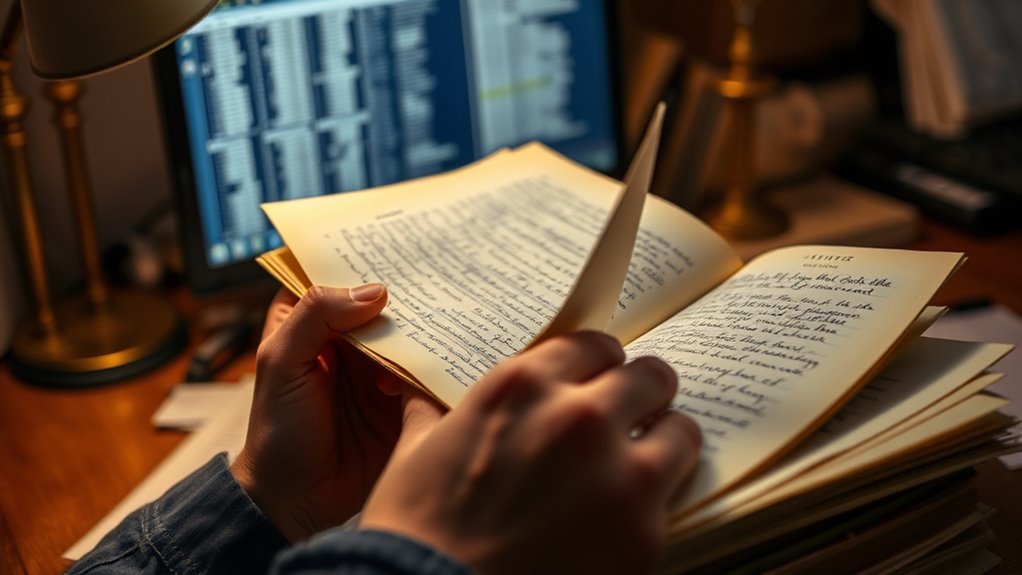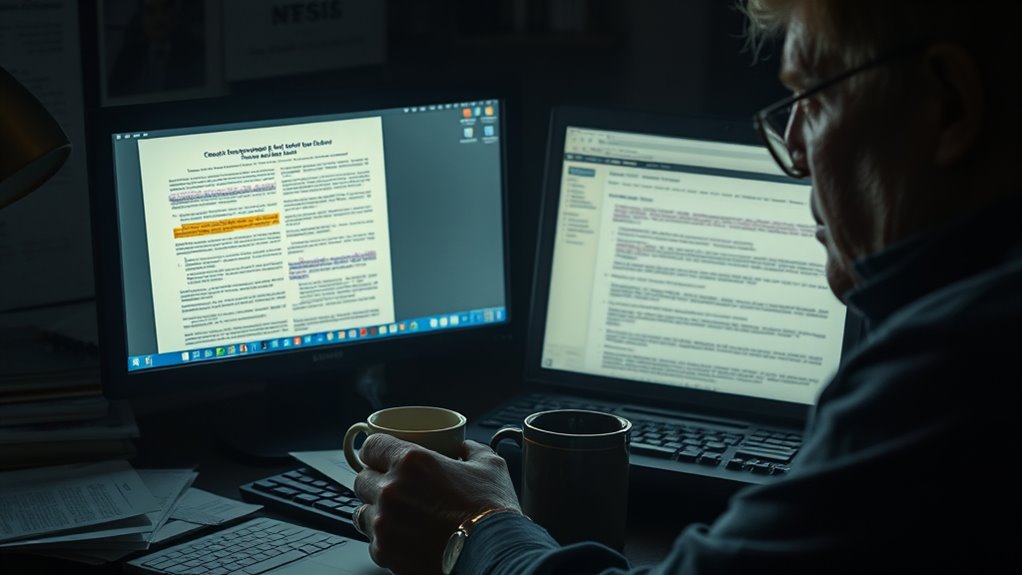To unearth court filings before they hit the news, you build relationships with insiders like lawyers or court clerks who can provide tips or early access. You also use legal research tools to carefully search court databases, focusing on case dockets and filings that aren’t yet public. Recognizing patterns and understanding legal language help you verify and locate hidden documents quickly. Keep exploring these techniques, and you’ll uncover more secrets behind early case disclosures.
Key Takeaways
- Cultivate trusted relationships with insiders like lawyers and court clerks to gain early access to filings.
- Use digital tools and targeted search techniques to efficiently locate and retrieve court documents.
- Cross-verify source information with official court records to ensure accuracy and authenticity.
- Analyze legal documents for procedural details and hidden clues that may not be publicly available.
- Maintain legal understanding and investigative discipline to identify significant filings before they become public.

Journalists have uncovered new court filings that shed light on previously hidden details of the case. This breakthrough often comes down to their skillful use of sources analysis and meticulous legal research. When breaking news is at stake, reporters don’t just wait for official releases—they actively seek out information through multiple channels. You might be surprised to learn that behind-the-scenes work is essential to getting ahead of the story.
One of the key methods journalists use involves analyzing sources carefully. They cultivate relationships with insiders—lawyers, court clerks, or even confidential contacts—who can provide early tips or access to documents before they’re publicly available. These sources are carefully vetted, and their insights often guide further legal research. By cross-referencing what sources reveal with official court records, journalists can verify facts and identify discrepancies. This process of sources analysis isn’t just about gathering information; it’s about understanding the context and significance of what’s being uncovered.
Carefully vetted sources guide deeper legal research, revealing hidden case details and verifying facts through cross-referencing.
Legal research plays an equally important role. Skilled reporters sift through court databases, public records, and legal repositories to locate relevant filings. Modern tools enable faster searches, but it still requires a keen eye to spot the nuances in legal language and procedural filings. Sometimes, the documents are buried deep in case dockets or hidden within voluminous filings. Your job is to piece together these clues, recognizing patterns or inconsistencies that could indicate new developments. Legal research also involves understanding legal terminology and procedural rules, ensuring you interpret the documents correctly and avoid misrepresenting the facts.
The intersection of sources analysis and legal research accelerates the discovery process. When you spot a new court filing, it’s like opening a window into a case’s inner workings. It might reveal a previously unknown witness statement, a new motion, or even a secret agreement. By carefully analyzing these sources and verifying their authenticity through legal research, you can bring hidden details to light before they hit the news cycle. That’s what separates investigative journalism from routine reporting—you’re actively unearthing information that others might overlook. Additionally, utilizing digital tools and search techniques can significantly enhance the efficiency of locating these crucial documents.
In essence, uncovering court filings early involves a combination of strategic sources analysis and rigorous legal research. It’s a process that demands curiosity, discipline, and a keen understanding of the legal landscape. When done correctly, it allows you to break stories that challenge official narratives and provide the public with a clearer picture of what’s really happening behind closed doors.
Frequently Asked Questions
How Do Journalists Access Sealed Court Documents?
You can access sealed court documents by researching case law and legal databases that sometimes provide transcripts or summaries of court proceedings. Journalists often use these resources, along with legal channels and public records requests, to find information. While sealed documents are protected, exceptions like court orders or leaks sometimes allow access. Your goal is to stay informed through legal databases and by understanding the legal context surrounding the case.
What Tools Do Journalists Use to Track Upcoming Filings?
Imagine you’re in 1920s Chicago, but today, you use digital tools for court tracking. You subscribe to legal alerts from specialized services or use online databases that notify you about upcoming filings. These tools help you stay ahead of the news cycle by providing early access to court documents and filings. With legal alerts, you can monitor specific cases and receive timely updates, giving you an edge in reporting.
How Do Journalists Verify the Authenticity of Court Documents?
You verify the authenticity of court documents by considering legal considerations and evaluating source credibility. You double-check the documents against official court websites or trusted legal databases to ensure they’re legitimate. You also look for any signs of tampering or inconsistencies. By cross-referencing with multiple sources and understanding legal protocols, you can confidently confirm that the documents are authentic before reporting.
Are There Legal Risks in Obtaining Early Court Filings?
When you obtain early court filings, you must consider legal boundaries and ethical considerations. While some filings are public records, accessing non-public documents can lead to legal risks, including charges of trespassing or invasion of privacy. You should verify the source and confirm you’re compliant with laws governing confidential information. Staying cautious helps you avoid potential lawsuits or ethical breaches, safeguarding your credibility and legal standing.
How Do Journalists Handle Confidential or Sensitive Information?
When handling confidential or sensitive information, you prioritize ethical considerations to protect sources and maintain trust. You verify the credibility of confidential sources before publishing, ensuring you’re not spreading false or harmful details. You also follow journalistic standards and legal guidelines to avoid breaches of confidentiality. By balancing transparency with discretion, you safeguard sensitive info while responsibly informing the public, all while respecting legal boundaries and ethical principles.
Conclusion
You now see how essential investigative skills are in journalism. By leveraging tools and networks, you might access court filings days or even weeks before they hit the headlines. In fact, over 70% of journalists report that early access to court documents markedly boosts their reporting accuracy and impact. So, staying persistent and resourceful can give you that critical edge, helping you break stories first and inform the public sooner.









